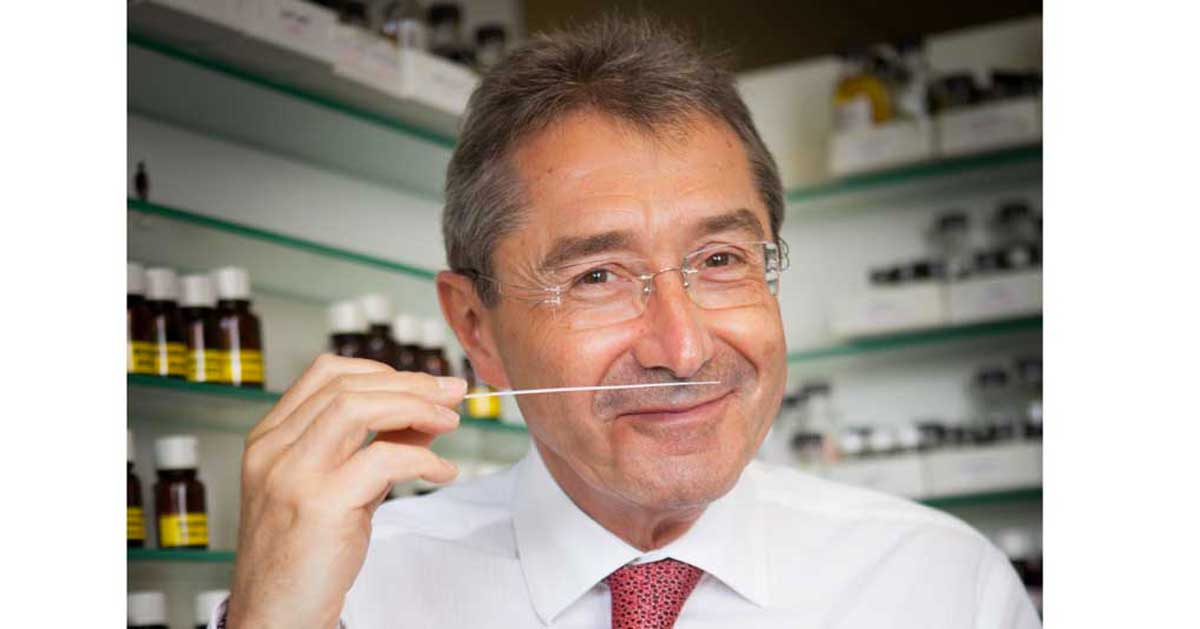Cette publication est également disponible en :
Français
This article was published in partnership with Mane.
Mane, the leading French perfume composition company, was founded in 1871 and has just celebrated its 150th anniversary. To mark the occasion, Jean Mane, its president, retraces the group’s environmentally responsible strategy, looking back at the key stages in building the business.
What are the different components of Mane’s environmentally responsible vision?
Green is the historic colour of our logo because the company has always been committed to sustainable development, respect for nature and biodiversity, right from its beginnings as a natural plant extraction company in the Grasse region. Even though we are now a group with a global presence, we care about every step involved in the production of fragrances, ingredients and flavours at the local scale.
This approach is reflected in our perfumers’ palette, which today comprises over 1,000 in-house ingredients, including more than 400 naturals, one of the broadest portfolios of naturals in the market, along with 50 biotech-derived molecules, responsibly sourced valuable ingredients, and our exclusive Jungle Essence extractions.
What were the key stages in building this strategy?
The fundamental stage is responsible sourcing, and in this field our pioneering presence in Madagascar since 1975 has taught us a great deal we can apply to all our initiatives elsewhere in the world. By working on the ecological, economic and social dimensions of growing vanilla and other local species, we have developed a sustainable ecosystem.
But we also chose very early on to work in what is now called green science, creating a department dedicated to biotechnologies in 1987. Initially applied to the production of flavours, we have also used them to provide molecules for perfumery, around fifty so far. They have countless benefits: 100% renewable carbon, energy and solvent savings, and optimised quality and costs.
In 2011, we took a major step forward by creating the first tool that allows a raw material to be given a score corresponding to its ecological footprint, and which has been the subject of a scientific publication, Green Motion, based on the twelve principles of green chemistry. It means we can now adopt a comprehensive approach to the environmental footprint of an ingredient, but also of all our fragrances. Our creators can use it to optimise their compositions and improve their environmental footprint. And it is also a useful tool to help our clients move towards a more sustainable path, and to pass on the information to consumers.
How can we reconcile global development and environmental responsibility?
We have a rare advantage in the fragrance industry: since its inception, our company has remained independent, keeping decisions in the hands of the Mane family, which has always been guided by a vision that respects people and the environment.
As the first fragrance and flavours company to sign the United Nations Global Compact in 2003, we have committed to a number of principles, including those relating to human rights, international labour standards, the environment and anti-corruption efforts.
At the global level, various committees take decisions and ensure consistency: executive committees for the three major regions (EMEA, the Americas and Asia), the scientific committee and the innovation committee. The choices are then communicated and implemented by all departments, in particular by the team in charge of CSR (Corporate Social Responsibility). This department was created in 2008 and currently coordinates 70 Mane units around the world. We published our first annual CSR report in 2009, aiming to make it as ambitious and demanding as a large company that has to answer to its shareholders – even though we are a family business – and to consumers – even though they only know us through our clients, the brands.
What major challenges lie ahead for Mane in terms of environmental responsibility?
Compositions used in perfumery currently contain an average of 35% natural ingredients. This proportion is on the rise, with some perfume houses trying to outdo each other in terms of the baseline number of natural products in each new perfume. This represents new technical challenges that we need to address while at the same time seeking to limit the impact of the extraction of these natural ingredients.
The perfumery industry is seeing the emergence of the “100% natural, 100% carbon renewable and 100% biodegradable” trend. We are therefore focusing our research on meeting this need. We are introducing processes to obtain new – as well as old – chemical products, based on synthons derived from biomass and not from petrochemicals, and using high-density, catalytic, continuous-flow reactions. However, this takes time and costs more. Will the consumer be ready to pay the higher price?
More about Mane : www.mane.com








Comments